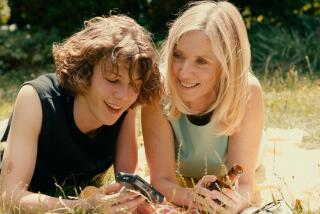Breillat keeps the liaisons dangerous
Art-HOUSE filmgoers have come to expect a self-described taste for provocation from director Catherine Breillat. Clinical, intellectually challenging depictions of female desire? Oui. Costume opulence? Not so much.
Her new film, “The Last Mistress,” an adaptation of the 1851 novel by Jules-Amedee Barbey d’Aurevilly, features its fair share of strikingly stylized couplings between Asia Argento’s title character -- a woman of such ferocious willfulness she’s said to out-stare the sun -- and Ryno, her longtime lover (newcomer Fu’ad Ait Aattou), a young man of impossibly delicate beauty. But perhaps what jolts most are the painterly instincts of the director that the film brings to the fore.
Speaking from Paris with the assistance of an interpreter, Breillat said that many facets of the story’s setting -- 1835 Paris -- attracted her.
“We find the last expression of the 18th century’s freedom of speech, which in the 19th century found itself opposed by the rise of liberalism, the rise of capitalism, the rapid expansion of industrialism. To me, these elements are very contemporary because for me there’s no difference between the 19th century and the 20th century in terms of our moralizing, in terms of the capitalism and rampant industrialism that we see. The only thing perhaps that has changed is that the rise of these elements is increasing and accelerating.”
As much as its free thinking, the aristocracy’s dandyism also drew Breillat to the tale of dangerous liaisons. She took particular delight in realizing an unaccustomed depth of visual detail on what was by far her largest budget to date, with a little more than $6 million.
Breillat had been accumulating props, costumes and material for about 10 years, and she insisted on authenticity, from original jewelry to antique handmade silk lace. “If you have a close-up of someone’s face with modern lace, the lace just falls flat, it doesn’t give the relief, it doesn’t give the resonance that you find with the authentic lace,” said Breillat, noting that she has long collected pieces of clothing because of their cinematic appeal, among them the red dress that appears in a scene of bondage ritual in her controversial 1999 film “Romance.”
For “Mistress,” which arrives in U.S. theaters on Friday, Breillat sought “people who didn’t have a sense of wearing costumes but who were living in the 18th and 19th century. I wanted real characters and not puppets.”
In expanding her canvas from the “chamber pieces” of her earlier films to a novelistic scope, the writer-director assembled a cast with widely divergent levels of experience. Ait Aattou, whom Breillat discovered in a Paris cafe, makes his screen-acting debut, as does 80-year-old Claude Sarraute, a longtime critic for Le Monde. Roxane Mesquida, whose first starring role was in Breillat’s 2001 “Fat Girl,” plays the third point in the central love triangle, the virginal princess to Argento’s fiery Vellini, the illegitimate daughter of an Italian princess and a Spanish bullfighter. Leading the aristocratic Greek chorus are seasoned pros Michael Lonsdale and Yolande Moreau.
Whether selecting first-timers or household names, Breillat casts films with instinctive alacrity, triumphantly referring to the chosen actors as “mine!”
“Deep down, I’m attracted by a certain kind of face, a certain kind of interiority . . . that makes me vibrate, that I’m in tune to, the same way that a painter may be attracted to a certain kind of landscape or a certain kind of light.”
Hey, good lookin’
Although THE fevered sexuality of Argento’s character is central to “Mistress,” the film’s chief concern is the young man Ryno, an object of desire. That’s something of a departure for the filmmaker but in a sense as much of a break with convention as her female-centric pieces have been.
Citing Michelangelo’s ideals of male beauty, Breillat noted drolly: “In American cinema you find handsome men, whereas in French cinema you find male stars who are usually not very good looking at all. Fifty years from now, when people watch French movies and see these absolutely ravishing actresses who fall head over heels in love with Gerard Depardieu, they’ll shake their heads and wonder what exactly was wrong with France.”
Breillat might have embraced more straightforward -- and less explicit -- storytelling in her 11th film, but she has no intention of relinquishing the mantle of provocateur. In October, she begins shooting her take on the bloody fairy tale “Bluebeard,” which she promises will scandalize. After that, she plans the “anything but politically correct” “Bad Love,” based on her own novel.
That the 59-year-old Breillat remains so busy after suffering a series of strokes -- a 2004 cerebral hemorrhage left her partially paralyzed and delayed “Mistress” by a year -- is a testament not only to her resilience but also to an urgent need to invent stories, whether scandalous, murderous or accented by handcrafted lace.
“When I was 12, I understood that I wasn’t made for this world and that I would have to inhabit a world of my own creation, a world in the movies. And now that’s even more true,” Breillat said. “When I show my actors what I want them to do on-screen, then I’m able to move exactly as I want. When I’m shooting a film, I’m never tired. I’m simply not made to inhabit a world of disabilities.”
More to Read
Only good movies
Get the Indie Focus newsletter, Mark Olsen's weekly guide to the world of cinema.
You may occasionally receive promotional content from the Los Angeles Times.










